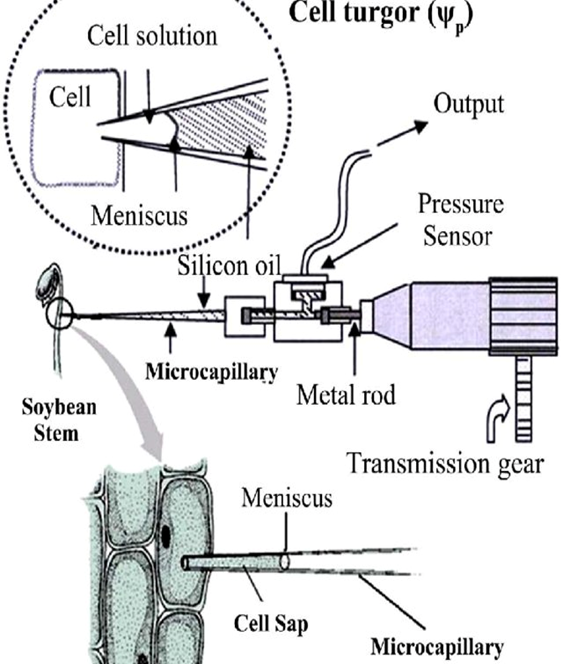Pressure Probe Method for Measuring Water Potential
Introduction:
The pressure probe method is a sophisticated technique used in plant physiology to directly measure water potential within plant cells. This method provides valuable insights into cellular water balance and is particularly instrumental in understanding how plants manage water under different environmental conditions.1. Working Principle:
The pressure probe method operates on the principle of directly measuring the pressure within a plant cell. A fine-tipped microelectrode is inserted into the cell, and the pressure necessary to balance the flow of water into or out of the cell is recorded. This pressure reading directly reflects the turgor pressure, a crucial component of the overall water potential within the cell.2. Apparatus and Setup:
Pressure Probe:
- The key tool in this method, the pressure probe, consists of a microelectrode with a sharp tip.
- The microelectrode is connected to a pressure transducer, converting pressure changes into measurable electrical signals.
Plant Sample Holder:
- The plant sample is carefully prepared and mounted to ensure stability during measurements.
Data Recording System:
- A system for recording and interpreting the electrical signals generated by the pressure probe.
3. Procedure:
Sample Preparation:
- A small section of the plant, often a leaf or stem, is selected for analysis.
- The sample is mounted in the holder, ensuring a secure and stable position.
Microelectrode Insertion:
- The microelectrode is delicately inserted into the plant cell, penetrating the cell membrane without causing significant damage.
Pressure Measurement:
- As the microelectrode enters the cell, it records the pressure necessary to stop water movement.
- The pressure reading is then converted into an electrical signal by the transducer.
Data Analysis:
- The recorded electrical signals are analyzed to determine the turgor pressure of the plant cell.
- Turgor pressure, along with other components, contributes to the overall water potential of the cell.
4. Applications:
- The pressure probe method is widely used in plant physiology research to understand cellular water regulation.
- It provides precise and direct measurements, allowing researchers to explore turgor pressure changes in response to various environmental factors.
5. Advantages:
- Precision:
- Offers high precision in directly measuring turgor pressure.
- Real-Time Measurements:
- Enables real-time monitoring of changes in cellular water potential.
6. Limitations:
- Invasive Technique:
- The method involves penetrating the cell membrane, which may affect the cell's physiological state.
- Skilled Expertise:
- Requires expertise in microelectrode insertion and data interpretation.
Conclusion:
The pressure probe method stands as a valuable tool for researchers delving into the intricate world of plant water relations. Its ability to provide direct and precise measurements contributes significantly to our understanding of how plants manage water potential in response to environmental challenges.
Frequently Asked Questions (FAQs) about Pressure Probe Method for Measuring Water Potential
1. What is the pressure probe method in plant physiology?
- The pressure probe method is a sophisticated technique used to directly measure turgor pressure within plant cells. It involves inserting a microelectrode into the cell to determine the pressure required to balance water movement.
2. How does the pressure probe method work?
- The method operates by inserting a microelectrode into a plant cell, recording the pressure necessary to stop water movement. This pressure reading directly reflects the turgor pressure, a critical component of cellular water potential.
3. What is the significance of turgor pressure in plant cells?
- Turgor pressure is essential for maintaining cell structure, rigidity, and overall cellular function. It contributes to the plant cell's water potential and plays a vital role in various physiological processes.
4. What components make up the pressure probe apparatus?
- The apparatus includes a pressure probe consisting of a microelectrode with a sharp tip, a plant sample holder for stability, and a data recording system connected to a pressure transducer.
5. Is the pressure probe method invasive to plant cells?
- Yes, the method involves inserting a microelectrode into the plant cell, which can be considered invasive. However, efforts are made to minimize damage and ensure the physiological state of the cell is not severely affected.
6. What types of plant samples are suitable for the pressure probe method?
- The method can be applied to various plant samples, including leaves and stems. The choice of sample depends on the specific research objectives.
7. How does the pressure probe method contribute to plant physiology research?
- The method provides precise and direct measurements of turgor pressure, allowing researchers to understand how plants regulate water potential in response to environmental conditions. It aids in studying cellular responses and adaptations.
8. Are there alternatives to the pressure probe method for measuring turgor pressure?
- Yes, alternative methods such as the pressure chamber method and the microcapillary technique exist. Each method has its advantages, and the choice depends on the specific requirements of the study.
9. What are the advantages of the pressure probe method?
- The method offers high precision in directly measuring turgor pressure. It enables real-time monitoring of changes in cellular water potential, providing valuable insights into dynamic cellular responses.
10. Are there limitations to the pressure probe method?
- The method is considered invasive, and the expertise required for microelectrode insertion and data interpretation may pose challenges. Additionally, the physiological state of the cell may be affected by the insertion process.

.jpg)




0 Comments